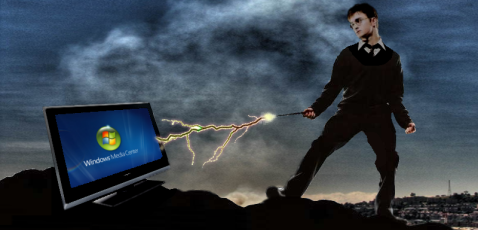Harry Potter and the search for a true Media Center experience

After spending hours researching, learning and trying to understand media streaming over a wireless network, I took a bold move and bought a Linksys Media Center Extender DMA2100 without entirely knowing what it would do, provide me, or even if it was what I wanted.
I took a stab in the dark and it turned out it was as near as dammit to what I wanted.

Before today, I wasn't able to differentiate between Apple TV, a media extender, a media streamer and a DVR. As a technology journalist it is a little embarrassing to admit. I knew what they did in theory but in principle, getting the right device to do exactly what you had hoped is something else.
For those who are not in the know, a media extender allows you to stream pictures, music or videos ("media" hereon in) over a network, wired or wireless, from a PC to a television or external monitor. In reality, a Windows Media Center extender streams the Windows Media Center application (ehshell.exe in Windows Vista and 7) over a network onto your television, giving you the same Windows Media Center experience on your television as you would on your PC.
You may have already switched the old noggin off for the weekend, so in pictogram form:
What you see on your television screen is essentially a remote desktop view of the Windows Media Center application. Once you hit the on button on your media extender and find the right TV extension number on your remote, you see the application as it would be on your PC. But on the PC, Windows Media Center is quietly running in the background and being projected over the wireless network to the television downstairs. I can still use my PC while it is running, including another instance of Windows Media Center if I choose.
Streaming the application itself looks slightly sluggish, even on an 802.11n (240mbps) network, and is clear to see especially in the menus. It feels like you are using it through a Terminal Server window. But when it comes to streaming video for example, there is no sluggishness or delay. It needs a little time - perhaps a few seconds depending on the video size - to buffer the video but experiences no lag or delay.
The media extender will give me everything that my PC has - including live TV if it has a TV card installed. While I can't directly test it, I'm unsure of whether it will really work. The only way I could watch live digital television using my media extender is if I plugged in a TV aerial coaxial cable into my desktop PC upstairs and streamed it over the network.
A simple, single question. Why can't you add a TV-in port to the extender and include a digital TV tuner?
Because now, I can watch all of my streamed media over the network from my PC without a problem, but to watch live television I have to switch from EX7-MEDIA to EX1-DTV on my remote. The reason why I bought an extender was through the sheer determination to expel all remote controls except for one single clicker.

I'm not saying that such a device exists, but having a combination of media streamers, extenders and digital video recorders would be perfect. Having a box which allows you to stream all kinds of media from a shared folder on your PC over a wireless N network - very much like an extender, along with in-built TV capabilities which receives digital TV signals and directly to your television - like Apple TV, but also a unit which has storage enabling you to record live TV and store it on your extender-come-digital TV box - like a DVR.
At least I can download a Harry Potter film and watch it on my 32" widescreen television without burning a single disk...